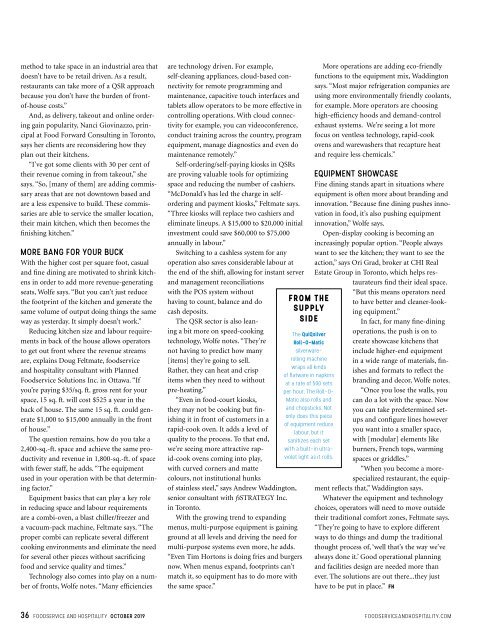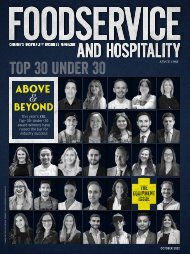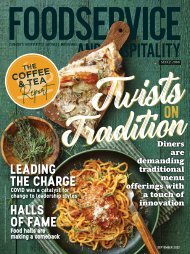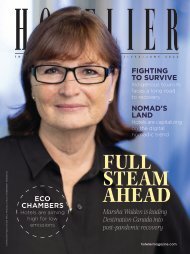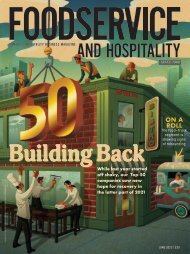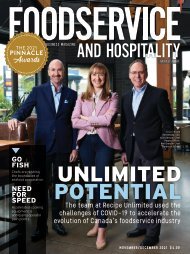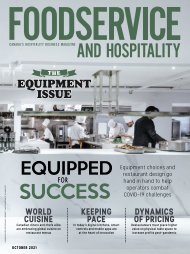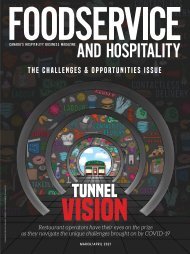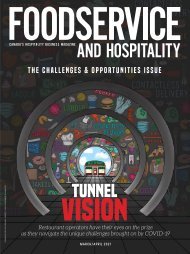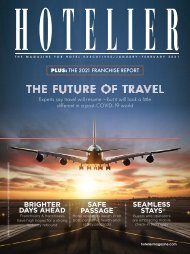October 2019 Digital Issue
Create successful ePaper yourself
Turn your PDF publications into a flip-book with our unique Google optimized e-Paper software.
method to take space in an industrial area that<br />
doesn’t have to be retail driven. As a result,<br />
restaurants can take more of a QSR approach<br />
because you don’t have the burden of frontof-house<br />
costs.”<br />
And, as delivery, takeout and online ordering<br />
gain popularity, Nanci Giovinazzo, principal<br />
at Food Forward Consulting in Toronto,<br />
says her clients are reconsidering how they<br />
plan out their kitchens.<br />
“I’ve got some clients with 30 per cent of<br />
their revenue coming in from takeout,” she<br />
says. “So, [many of them] are adding commissary<br />
areas that are not downtown based and<br />
are a less expensive to build. These commissaries<br />
are able to service the smaller location,<br />
their main kitchen, which then becomes the<br />
finishing kitchen.”<br />
MORE BANG FOR YOUR BUCK<br />
With the higher cost per square foot, casual<br />
and fine dining are motivated to shrink kitchens<br />
in order to add more revenue-generating<br />
seats, Wolfe says. “But you can’t just reduce<br />
the footprint of the kitchen and generate the<br />
same volume of output doing things the same<br />
way as yesterday. It simply doesn’t work.”<br />
Reducing kitchen size and labour requirements<br />
in back of the house allows operators<br />
to get out front where the revenue streams<br />
are, explains Doug Feltmate, foodservice<br />
and hospitality consultant with Planned<br />
Foodservice Solutions Inc. in Ottawa. “If<br />
you’re paying $35/sq. ft. gross rent for your<br />
space, 15 sq. ft. will cost $525 a year in the<br />
back of house. The same 15 sq. ft. could generate<br />
$1,000 to $15,000 annually in the front<br />
of house.”<br />
The question remains, how do you take a<br />
2,400-sq.-ft. space and achieve the same productivity<br />
and revenue in 1,800-sq.-ft. of space<br />
with fewer staff, he adds. “The equipment<br />
used in your operation with be that determining<br />
factor.”<br />
Equipment basics that can play a key role<br />
in reducing space and labour requirements<br />
are a combi-oven, a blast chiller/freezer and<br />
a vacuum-pack machine, Feltmate says. “The<br />
proper combi can replicate several different<br />
cooking environments and eliminate the need<br />
for several other pieces without sacrificing<br />
food and service quality and times.”<br />
Technology also comes into play on a number<br />
of fronts, Wolfe notes. “Many efficiencies<br />
are technology driven. For example,<br />
self-cleaning appliances, cloud-based connectivity<br />
for remote programming and<br />
maintenance, capacitive touch interfaces and<br />
tablets allow operators to be more effective in<br />
controlling operations. With cloud connectivity<br />
for example, you can videoconference,<br />
conduct training across the country, program<br />
equipment, manage diagnostics and even do<br />
maintenance remotely.”<br />
Self-ordering/self-paying kiosks in QSRs<br />
are proving valuable tools for optimizing<br />
space and reducing the number of cashiers.<br />
“McDonald’s has led the charge in selfordering<br />
and payment kiosks,” Feltmate says.<br />
“Three kiosks will replace two cashiers and<br />
eliminate lineups. A $15,000 to $20,000 initial<br />
investment could save $60,000 to $75,000<br />
annually in labour.”<br />
Switching to a cashless system for any<br />
operation also saves considerable labour at<br />
the end of the shift, allowing for instant server<br />
and management reconciliations<br />
with the POS system without<br />
having to count, balance and do<br />
cash deposits.<br />
The QSR sector is also leaning<br />
a bit more on speed-cooking<br />
technology, Wolfe notes. “They’re<br />
not having to predict how many<br />
[items] they’re going to sell.<br />
Rather, they can heat and crisp<br />
items when they need to without<br />
pre-heating.”<br />
“Even in food-court kiosks,<br />
they may not be cooking but finishing<br />
it in front of customers in a<br />
rapid-cook oven. It adds a level of<br />
quality to the process. To that end,<br />
we’re seeing more attractive rapid-cook<br />
ovens coming into play,<br />
with curved corners and matte<br />
colours, not institutional hunks<br />
of stainless steel,” says Andrew Waddington,<br />
senior consultant with fsSTRATEGY Inc.<br />
in Toronto.<br />
With the growing trend to expanding<br />
menus, multi-purpose equipment is gaining<br />
ground at all levels and driving the need for<br />
multi-purpose systems even more, he adds.<br />
“Even Tim Hortons is doing fries and burgers<br />
now. When menus expand, footprints can’t<br />
match it, so equipment has to do more with<br />
the same space.”<br />
FROM THE<br />
SUPPLY<br />
SIDE<br />
More operations are adding eco-friendly<br />
functions to the equipment mix, Waddington<br />
says. “Most major refrigeration companies are<br />
using more environmentally friendly coolants,<br />
for example. More operators are choosing<br />
high-efficiency hoods and demand-control<br />
exhaust systems. We’re seeing a lot more<br />
focus on ventless technology, rapid-cook<br />
ovens and warewashers that recapture heat<br />
and require less chemicals.”<br />
EQUIPMENT SHOWCASE<br />
Fine dining stands apart in situations where<br />
equipment is often more about branding and<br />
innovation. “Because fine dining pushes innovation<br />
in food, it’s also pushing equipment<br />
innovation,” Wolfe says.<br />
Open-display cooking is becoming an<br />
increasingly popular option. “People always<br />
want to see the kitchen; they want to see the<br />
action,” says Ori Grad, broker at CHI Real<br />
Estate Group in Toronto, which helps restaurateurs<br />
find their ideal space.<br />
“But this means operators need<br />
to have better and cleaner-looking<br />
equipment.”<br />
In fact, for many fine-dining<br />
CAMERA-READY LOGOTYPE – UL MARK FOR CANADA AND THE U<br />
The QuiQsilver operations, the push is on to<br />
Roll-O-Matic create showcase kitchens that<br />
silverwarerolling<br />
machine in a wide range of materials, fin-<br />
include higher-end equipment<br />
wraps all kinds<br />
ishes and formats to reflect the<br />
of flatware in napkins<br />
at a rate of 500 sets branding and decor, Wolfe notes.<br />
per hour. The Roll-O- “Once you lose the walls, you<br />
Matic also rolls and can do a lot with the space. Now<br />
and chopsticks. Not you can take predetermined setups<br />
and configure lines however<br />
only does this piece<br />
of equipment reduce<br />
labour, but it you want into a smaller space,<br />
sanitizes each set with [modular] elements like<br />
with a built-in ultraviolet<br />
light as it rolls. spaces or griddles.”<br />
burners, French tops, warming<br />
“When you become a morespecialized<br />
restaurant, the equipment<br />
reflects that,” Waddington says.<br />
Whatever the equipment and technology<br />
choices, operators will need to move outside<br />
their traditional comfort zones, Feltmate says.<br />
“They’re going to have to explore different<br />
ways to do things and dump the traditional<br />
thought process of, ‘well that’s the way we’ve<br />
always done it.’ Good operational planning<br />
and facilities design are needed more than<br />
ever. The solutions are out there...they just<br />
have to be put in place.” FH<br />
36 FOODSERVICE AND HOSPITALITY OCTOBER <strong>2019</strong> FOODSERVICEANDHOSPITALITY.COM


